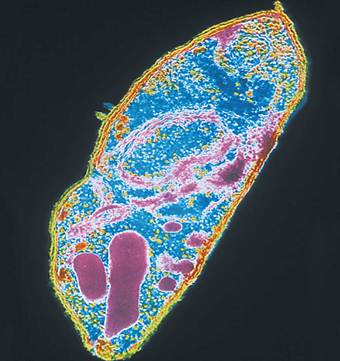

النبات

مواضيع عامة في علم النبات

الجذور - السيقان - الأوراق

النباتات الوعائية واللاوعائية

البذور (مغطاة البذور - عاريات البذور)

الطحالب

النباتات الطبية


الحيوان

مواضيع عامة في علم الحيوان

علم التشريح

التنوع الإحيائي

البايلوجيا الخلوية


الأحياء المجهرية

البكتيريا

الفطريات

الطفيليات

الفايروسات


علم الأمراض

الاورام

الامراض الوراثية

الامراض المناعية

الامراض المدارية

اضطرابات الدورة الدموية

مواضيع عامة في علم الامراض

الحشرات


التقانة الإحيائية

مواضيع عامة في التقانة الإحيائية


التقنية الحيوية المكروبية

التقنية الحيوية والميكروبات

الفعاليات الحيوية

وراثة الاحياء المجهرية

تصنيف الاحياء المجهرية

الاحياء المجهرية في الطبيعة

أيض الاجهاد

التقنية الحيوية والبيئة

التقنية الحيوية والطب

التقنية الحيوية والزراعة

التقنية الحيوية والصناعة

التقنية الحيوية والطاقة

البحار والطحالب الصغيرة

عزل البروتين

هندسة الجينات


التقنية الحياتية النانوية

مفاهيم التقنية الحيوية النانوية

التراكيب النانوية والمجاهر المستخدمة في رؤيتها

تصنيع وتخليق المواد النانوية

تطبيقات التقنية النانوية والحيوية النانوية

الرقائق والمتحسسات الحيوية

المصفوفات المجهرية وحاسوب الدنا

اللقاحات

البيئة والتلوث


علم الأجنة

اعضاء التكاثر وتشكل الاعراس

الاخصاب

التشطر

العصيبة وتشكل الجسيدات

تشكل اللواحق الجنينية

تكون المعيدة وظهور الطبقات الجنينية

مقدمة لعلم الاجنة


الأحياء الجزيئي

مواضيع عامة في الاحياء الجزيئي


علم وظائف الأعضاء


الغدد

مواضيع عامة في الغدد

الغدد الصم و هرموناتها

الجسم تحت السريري

الغدة النخامية

الغدة الكظرية

الغدة التناسلية

الغدة الدرقية والجار الدرقية

الغدة البنكرياسية

الغدة الصنوبرية

مواضيع عامة في علم وظائف الاعضاء

الخلية الحيوانية

الجهاز العصبي

أعضاء الحس

الجهاز العضلي

السوائل الجسمية

الجهاز الدوري والليمف

الجهاز التنفسي

الجهاز الهضمي

الجهاز البولي


المضادات الميكروبية

مواضيع عامة في المضادات الميكروبية

مضادات البكتيريا

مضادات الفطريات

مضادات الطفيليات

مضادات الفايروسات

علم الخلية

الوراثة

الأحياء العامة

المناعة

التحليلات المرضية

الكيمياء الحيوية

مواضيع متنوعة أخرى

الانزيمات
Protozoan Diseases
المؤلف:
Cheng, Thomas C
المصدر:
General Parasitology
الجزء والصفحة:
28-10-2015
1865
Protozoan Diseases
Protozoans are a group of eukaryotic single-celled organisms. Several species of protozoans infect humans and inhabit the body as commensals or parasites. The parasitic protozoans of major medical importance include certain species of amoebae, flagellates, and sporozoans.
Amoebae
The most notorious amoeba of humans is Entamoeba histolytica, an inhabitant of the large intestine. Although often harmless, it can become invasive, penetrating into the mucous membrane of the intestine, multiplying and eroding the tissue. The result is a disease called amebiasis, characterized by intense abdominal pain, blood and mucus in the stool, diarrhea, and dehydration (a syndrome called amebic dysentery). Amebiasis can be fatal, especially to infants and children.
In addition to the intestinal infection, the amoebae sometimes get into the bloodstream and establish secondary sites of infection in the liver, brain, or elsewhere. Entamoeba histolytica is acquired from food or water contaminated with sewage. Several other amoebae, such as Entamoeba coli, inhabit the human intestine with little or no harm to the host, but their presence indicates that the person has ingested food or water contaminated with human feces and may be at risk of more serious infections.
Flagellates
The world’s most common cause of water-borne diarrhea is the flagellate Giardia lamblia. Outbreaks of giardiasis are common in schools, mental hospitals, prisons, and other crowded institutions, but occur in circumstances as diverse as luxury resorts, backcountry camping, and impoverished villages. Giardia attaches to the surface of the small intestine, often in numbers great enough to seriously interfere with nutrient absorption. Unabsorbed nutrients then pass to the large intestine and cause gas production, painful abdominal cramps, and diarrhea.
In Africa, tsetse flies transmit another parasitic flagellate, Trypanosoma, which causes African sleeping sickness. Victims become fatigued, emaciated, and eventually lapse into a coma and die. Even though it does not occur in the United States, trypanosomiasis is one of the world’s leading public health problems.
Sporozoans
Malaria is another leading cause of death in tropical countries. It is caused by four species of the protozoan genus Plasmodium. Transmitted by mosquitoes, Plasmodium multiplies in the liver and then invades the red blood cells, destroying them so extensively as to cause severe anemia. The victim experiences alternating fever and chills as the parasites emerge together from infected red cells, invade new ones, multiply, and repeat the cycle until finally the victim is overcome by exhaustion.
Another sporozoan disease is toxoplasmosis, caused by Toxoplasma gondii. Toxoplasma can be contracted from unpasteurized milk, undercooked meat, or house cats. It causes little pathology in adults, but when a pregnant woman is infected, it can cause serious fetal deformities resulting in infant blindness, hydrocephalus, and physical and mental retardation.

An electron micrograph of Plasmodium falciparum one of the parasites that causes malaria
References
Cheng, Thomas C. General Parasitology, 2nd ed. Orlando, FL: Academic Press, 1986.
Schmidt, Gerald D., and Larry S. Roberts. Foundations of Parasitology. 6th ed.
Dubuque, IA: McGraw-Hill Higher Education, 2000.
 الاكثر قراءة في الطفيليات
الاكثر قراءة في الطفيليات
 اخر الاخبار
اخر الاخبار
اخبار العتبة العباسية المقدسة

الآخبار الصحية















 قسم الشؤون الفكرية يصدر كتاباً يوثق تاريخ السدانة في العتبة العباسية المقدسة
قسم الشؤون الفكرية يصدر كتاباً يوثق تاريخ السدانة في العتبة العباسية المقدسة "المهمة".. إصدار قصصي يوثّق القصص الفائزة في مسابقة فتوى الدفاع المقدسة للقصة القصيرة
"المهمة".. إصدار قصصي يوثّق القصص الفائزة في مسابقة فتوى الدفاع المقدسة للقصة القصيرة (نوافذ).. إصدار أدبي يوثق القصص الفائزة في مسابقة الإمام العسكري (عليه السلام)
(نوافذ).. إصدار أدبي يوثق القصص الفائزة في مسابقة الإمام العسكري (عليه السلام)


















